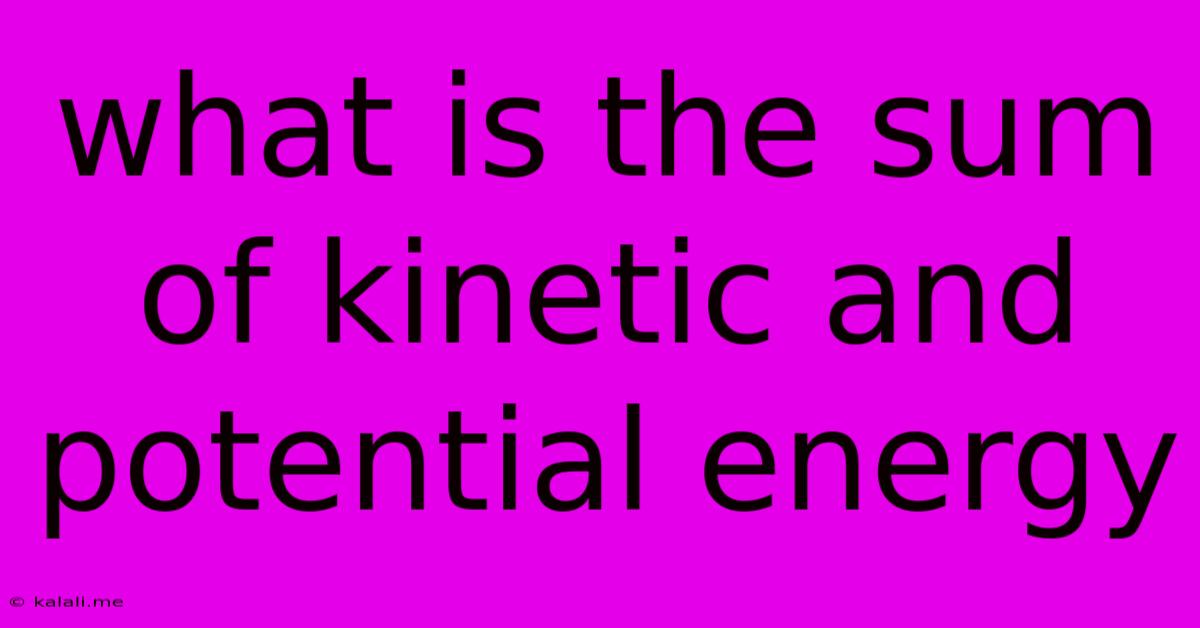What Is The Sum Of Kinetic And Potential Energy
Kalali
Jun 14, 2025 · 3 min read

Table of Contents
What is the Sum of Kinetic and Potential Energy? Understanding Mechanical Energy
The sum of kinetic and potential energy is known as mechanical energy. This fundamental concept in physics describes the total energy possessed by an object due to its motion and position within a system. Understanding mechanical energy is crucial for analyzing various physical phenomena, from a simple pendulum swing to the complex motion of planets. This article will delve into the specifics of kinetic and potential energy, their interplay, and the significance of their sum.
What is Kinetic Energy?
Kinetic energy is the energy an object possesses due to its motion. The faster an object moves and the greater its mass, the more kinetic energy it has. This energy is directly related to the object's velocity. Mathematically, kinetic energy (KE) is expressed as:
KE = 1/2 * mv²
where:
- m = mass of the object
- v = velocity of the object
A bowling ball rolling down a lane, a car speeding down a highway, or even a molecule vibrating – all possess kinetic energy. The energy is transferred through collisions or interactions with other objects.
What is Potential Energy?
Potential energy, on the other hand, is stored energy that an object possesses due to its position or configuration within a force field. The most common type is gravitational potential energy, which depends on an object's height above a reference point (typically the ground). Other forms include elastic potential energy (stored in a stretched spring or rubber band) and chemical potential energy (stored in bonds between atoms).
Gravitational potential energy (GPE) is calculated as:
GPE = mgh
where:
- m = mass of the object
- g = acceleration due to gravity
- h = height of the object above the reference point
A book resting on a shelf, a stretched rubber band, or water stored behind a dam all possess potential energy. This energy has the potential to be converted into kinetic energy under the right circumstances.
The Interplay of Kinetic and Potential Energy: The Conservation of Mechanical Energy
In a closed system where only conservative forces (like gravity) are acting, the total mechanical energy remains constant. This is known as the principle of conservation of mechanical energy. This means that energy is neither created nor destroyed; it simply changes form between kinetic and potential energy.
Consider a simple pendulum: At its highest point, the pendulum has maximum potential energy and zero kinetic energy (it's momentarily stationary). As it swings down, potential energy is converted into kinetic energy, reaching maximum kinetic energy at the bottom of its swing. The process reverses as it swings back up, converting kinetic energy back into potential energy. Ignoring energy losses due to friction and air resistance, the total mechanical energy (KE + PE) remains constant throughout the pendulum's motion.
Examples of Mechanical Energy in Action:
- Rollercoaster: A rollercoaster car at the top of a hill possesses maximum potential energy. As it descends, potential energy converts to kinetic energy, increasing its speed.
- Skydiver: A skydiver jumping from a plane initially possesses high potential energy. As they fall, potential energy converts to kinetic energy, resulting in increased speed.
- Projectile motion: A ball thrown upwards converts kinetic energy to potential energy as it rises, then back to kinetic energy as it falls.
Factors Affecting Mechanical Energy:
Several factors can influence the total mechanical energy of a system. Non-conservative forces like friction and air resistance dissipate energy as heat, reducing the total mechanical energy over time. External forces can also add or remove energy from the system.
In conclusion, the sum of kinetic and potential energy represents the total mechanical energy of a system. Understanding this concept is essential for comprehending various physical phenomena and applying principles of energy conservation. While ideal systems maintain constant mechanical energy, real-world scenarios involve energy loss due to non-conservative forces.
Latest Posts
Latest Posts
-
What Is The Difference Between Pounds And Kilograms
Jun 15, 2025
-
Which Of The Following Is An Incorrect Statement
Jun 15, 2025
-
Lcm Of 6 12 And 8
Jun 15, 2025
-
What Is Si Unit Of Frequency
Jun 15, 2025
-
The Unit Of Measurement For Sound Wave Frequency Is
Jun 15, 2025
Related Post
Thank you for visiting our website which covers about What Is The Sum Of Kinetic And Potential Energy . We hope the information provided has been useful to you. Feel free to contact us if you have any questions or need further assistance. See you next time and don't miss to bookmark.